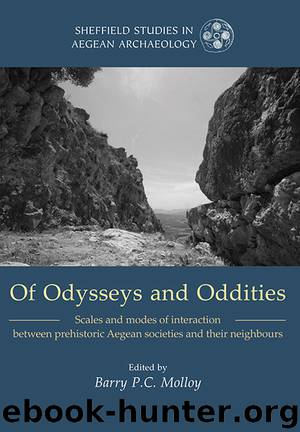Of Odysseys and Oddities by Barry Molloy

Author:Barry Molloy
Language: eng
Format: epub
ISBN: 9781785702327
Publisher: Casemate Publishers & Book Distributors, LLC
Published: 2016-03-14T16:00:00+00:00
Western Anatolia
At the site of Demircihüyük near Eskisehir a single sealing with fabric imprints on the back was found in a pit in Room 200 of the Phase F2 (Obladen-Kauder 1996: 321, pl. 136, 5). This phase could be paralleled with Troy Ib, according to Efe (1988: 117, fig. 98). The imprint of the seal shows a row of squares which were rolled or impressed on the clay (Obladen-Kauder 1996: 286). Finally, a sealing came to light at Emalı-Karataş in south-western Anatolia in a trench between a small fortified hill (with just a large single-room building) and the settlement. It belongs to Level III of the site (Mellink 1972, 258–259, pl. 55, 5). Karataş III is dated by J. Warner to the EBA Ib of M. Mellink chronological scheme. This would imply an approximate absolute date around the 28th or 27th century BC (Warner 1996: 7–10, chart 11; Efe and Türkteki 2011: 190, Tab.). The motif of an angle-filled cross appears to be impressed on a sealing from Boz Höyük-Dinar near Kusura (Mellaart 1954: 216, 239, fig. 466). It is a surface find but at this site Chalcolithic and EBA pottery was found (Mellaart 1954: 181, 192, fig. 2–3). With Alişar Höyük we are already in central Anatolia. There, a ‘fragmentary sun-dried mud brick’ (von der Osten 1937: 81–82, fig. 87, e 1974) was excavated in layers of the ‘Copper Age’ of the site’s sequence. Unfortunately, the amorphous object has not been published, but on its backside there appears to be an image that may be a potential sealing. On the same plate in the publication several seals with the angle-filled cross motif are illustrated (von der Osten 1937: 81–82, fig. 87, c 576). A total of only four EBA sites with sealings in Western and Central Anatolia might appear as weak evidence for an assumed reconstruction of a widespread seal-use, but one has to remember that much fewer Anatolian sites of this period have been published in comparison to the Aegean.
Download
This site does not store any files on its server. We only index and link to content provided by other sites. Please contact the content providers to delete copyright contents if any and email us, we'll remove relevant links or contents immediately.
| Africa | Americas |
| Arctic & Antarctica | Asia |
| Australia & Oceania | Europe |
| Middle East | Russia |
| United States | World |
| Ancient Civilizations | Military |
| Historical Study & Educational Resources |
Cecilia; Or, Memoirs of an Heiress — Volume 1 by Fanny Burney(31361)
Cecilia; Or, Memoirs of an Heiress — Volume 3 by Fanny Burney(30958)
Cecilia; Or, Memoirs of an Heiress — Volume 2 by Fanny Burney(30915)
The Secret History by Donna Tartt(16695)
Sapiens: A Brief History of Humankind by Yuval Noah Harari(13100)
Leonardo da Vinci by Walter Isaacson(11938)
The Radium Girls by Kate Moore(10935)
Sapiens by Yuval Noah Harari(4567)
How Democracies Die by Steven Levitsky & Daniel Ziblatt(4437)
The Wind in My Hair by Masih Alinejad(4435)
Homo Deus: A Brief History of Tomorrow by Yuval Noah Harari(4301)
Endurance: Shackleton's Incredible Voyage by Alfred Lansing(3863)
The Silk Roads by Peter Frankopan(3804)
Man's Search for Meaning by Viktor Frankl(3662)
Millionaire: The Philanderer, Gambler, and Duelist Who Invented Modern Finance by Janet Gleeson(3586)
The Rape of Nanking by Iris Chang(3537)
Hitler in Los Angeles by Steven J. Ross(3456)
The Motorcycle Diaries by Ernesto Che Guevara(3353)
Joan of Arc by Mary Gordon(3276)
